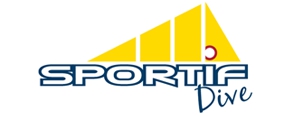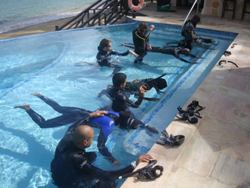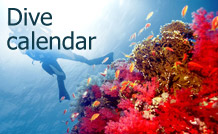2024 - 2025 Scuba Diving Holidays, Liveaboards and Learn to Dive Courses to the Maldives, Red Sea, Canary Islands, Far East, Caribbean and the Pacific.
Tobago Dive Sites - Tobago, Caribbean
Diving in Tobago can be separated into three areas, the Caribbean coast, South coast and the North East Coast, not only for geographic purposes but also for diving diversity. See our quick guide to the best sites.
The Caribbean Coast
The Caribbean Coast stretches from Store Bay to Charlotteville and can generally be described as rock reefs with encrusting sponge and coral growth, but also comprises the diving highlights of the wreck M.V. Maverick and pinnacles - The Sisters - Manta and Hammerhead site in season.
Kariwak Reef 6-12m
Located in Store Bay, this site is quite often used for check dives or tuition. It is home to one of the largest Green Morays you’ll ever set eyes on and be sure to look for juvenile Hawksbill Turtles.
Mount Irvine Wall 8-16m
More of a picket fence than a wall, this site is great for searching out the unusual. With lots of crevices, you’ll see more Octopi here than on any other site. Hawksbill Turtles are common as are a variety of Morays, with occasional appearances by Eagle Rays, Seahorses and Bat fish.
The Sisters 15-30m
Cold upwellings from December through to April, draw Scalloped Hammerhead Sharks closer into these pinnacles. Averaging nine feet in length, an encounter with the ‘big boys’ is sure to make for a memorable dive. On the other end of the scale, keep your eyes open for the rare dwarf Angel Fishes such as Cherub Fish and Flameback Angels.
M.V. Maverick 15-30m
Originally named the M.V. Scarlet Ibis, this car ferry once provided a vital link between Tobago and Trinidad. She now provides shelter for a number of fish and a playground for divers, since being deliberately sunk in 1997 as an artificial reef. Laying perfectly upright on the sea floor, she gives the appearance of still being underway.
The South Coast
The South Coast is bathed by the Atlantic Ocean and hosts true drift diving conditions. The dive sites are a mixture of coral reef, rocky ledges and wrecks, providing more encounters with Stingrays, Hawksbill Turtles and Nurse Sharks than anywhere else on the island.
Cove Ledge 9-12m
The ledge shelters Green Morays, Hawksbill Turtles and Nurse Sharks.
Diver’s Dream 15-20m
A plateau 3 km south of the Airport, this site plays home to huge schools of Grunts and Snapper and provides encounters with Barracuda, Stingrays, Hawksbill Turtles, Eagle Rays, Nurse and Black Tip Reef Sharks plus schooling pelagics such as Horse Eyed Jacks.
Flying Reef 10-16m
This favourite runs parallel to Tobago’s runway and, with the right drift, will allow you to cover over a mile of reef during a single dive. Multiple sightings of Stingrays and Hawksbill Turtles occur on this dive, and sightings of the rare Cornet fish are fairly common.
S.S. Kioto 12m
Built in 1918, this 347 foot British merchantman met her end on the 15th September 1942 at the hands of Hans Juergen Auffermann, the commander of U-514. Due to the shallow depth, she has broken open over the years with the boilers and propeller providing excellent photo opportunities, as do schooling Barracuda and Nurse Sharks.
The North East Coast
The North East Coast offers truly exciting diving. Fast drifts, spectacular underwater topography, caves, swim throughs and more. The largest brain coral in the world is a must see. Mantas and Hammerheads in season. For those who enjoy more relaxing sites very little to no current sites allow you to go at your own pace or gain experience.
Angel Reef 15-18m
This reef is shallow enough for snorkelers and glass-bottomed boats, but is also used as a dive site. It is located just off Goat Island, where Ian Fleming, author of the James Bond 007 novels, used to own a house. The dive starts on a flat area of the reef, where the Japanese Gardens ends. The current starts out slow, but as you move down towards the slope, into the main stream and you will begin to pick up speed. See little grooves and canyons in which the fish hide. Tangs, sergeant majors, trumpet-fish and Spanish hogfish all call this reef home.
Coral Gardens Angel (Kelliston Drain) 9-20m
This site, also called Kelliston Drain (if done on the deep side), just off Little Tobago, features both hard and soft corals, but mostly the latter. Barracuda and trunkfish are common here. What is believed to be the world’s largest brain coral calls this reef home. It is 16 feet in diameter..
Cathedral 15-18m
November through June, you can experience Tobago's famous encounters with the elusive manta ray. This site is one of their regular hot spots. It is a gently sloping reef with fairly consistent mild currents, usually flowing north. Fish calling this reef home include: creole wrasse, black durgeon, angelfish and tiger grouper.
Sometimes, the northernmost end of this reef is dived as another site called Flying Manta. It all depends on where you enter the water and where the currents take you. Beware of an area to the northwest of Little Tobago known as the "washing machine." The swirling currents create a whirlpool effect making it a dangerous dive. Do not consider diving this area unless you are accompanied by an experienced local divemaster.
Black Jack Hole 15-18m
Black Jack Hole is a sloping reef that runs from the southwest corner of Little Tobago to Coral Gardens (also known as Kelliston Drain Reef). The site is named for the abundant schools of black jacks and chromis that call the area home. Apparently attracted by the whirlpool of currents here, a family of dolphins is a frequent visitor. Playful antics and joyous merriment best describe the activities of these fascinating animals.
Known inhabitants include: black durgeon, southern serrat, chromis, boga, sharks, rays, and dolphin. Green moray eels, black tip sharks, purple and gold creole wrasses make for lots of photo opportunities.
Japenese Gardens 5-25m
This site gets its name from the sea whip corals which resemble Japanese bonsai trees. It seems almost as if a Japanese artist sat down and painted his royal garden. This site features many hard and soft corals. It is a shallow sloping reef that begins at 30 ft and tumbles down gracefully to 100 ft. Just when you are sure that your leisurely visit is complete, we encounter the "Kamikaze Cut." The current picks up speed and you come barreling down towards two huge boulders, sure that the coming impact will spoil your day. But wait, you discover that a crevasse has been cut through the rocks and you pass between them, slow down, and find yourself returned to the calm and tranquil waters of Tobago. Nurse sharks, large barracudas like to hang out near the small caves at this site. There are large brain corals and large schools of jacks. Ian Fleming, author of the James Bond 007 novels, owned a house near here, on Goat Island. This site has beautiful coral formations and little current. Manta rays, tarpon, and barracuda are schooling fish frequently found here. This site is for beginners thru advance.
Bookends
Two stately nubs of black granite break through the surface providing the classic set of Bookends, but also make for rough surface conditions, which classify this dive as intermediate in difficult. To start, you pass between the rocks into a large bowl, which is about 35 feet deep. It accommodates about 10 divers. Look up and you will see the waves breaking over the bowl. It looks very similar to storm clouds passing overhead. Don't be surprised if you see what looks like a large airplane shooting across, it's just a tarpon. A school of the large fish has claimed this turf as their own. As you continue to drift at about 50 feet, you will also see jacks, parrotfish, trumpetfish, and grouper that live among the giant barrel sponges. The mild current propels you along a gentle sloping wall. The current seems to tease you by drawing you into deeper water. Intermediate to Advanced. 50 to 60 ft.
Alps
If the idea of wind blowing through your hair excites you, then the Alps are for you. There is no skiing here but plenty of current and great diving. Huge mountain-like formations give this locale its name because it resembles a view of the Alps. Outstanding underwater mountain peaks seem ready for skiers. The currents are strong and unpredictable. Don’t be surprised if bubbles descend before beginning to rise. The dive begins with a swim through an Alpine mountain-like passage. This site is just on the other side of Bookends. It attracts many reef fish and invertebrates. You will see tangs and parrotfish as well as many gray and French angelfish. Tarpon and sharks are also found here occasionally. Advanced.
Special
This site just south of Little Tobago Island features a knife edge ridge of coral covered volcanic rock barely breaking the surface, coral covered slopes and canyons with an abundance of fish. Marine life featured at this site include: blue head wrasse, rainbow runners, green morays and African pompanos.
Sleeper 7
This reef has it all from shear walls and long slopes to level plains and striking canyons along with abundant marine life.
Aquarium
This site is loaded with fish, which explains its name. It features black durgeon, glassy eyed snapper and angelfish to name only a few of the species found here. It's a spectacular drift dive. This reef is very versatile. The gently sloping area of the reef is perfect for navigational training. Depths start as shallow as 12 ft and go all the way down to 150 ft. But look out for those changing currents! There are other interesting areas of this site to explore too. Rocky overhangs and ledges marked by two rocks further out on the reef create a beautiful marine habitat. All skill levels.
Flying Manta
This site is very similar to the Cathedral site since it starts where Cathedral ends. It features much of the same marine life.
Picker
Because of the rough surface conditions, this site is reserved for intermediate to advanced divers and, even with this restriction, is visited only when weather conditions permit. Large pelagic fish, nurse sharks, barracuda, black and crevalle jacks, tarpon, mackerel, moray eels, lobsters and mantas frequent this area. The dive is along a slope with a rocky bottom and plenty of hard corals. Even on a bad day there is an abundance of fish.
London Bridge Rock
The forces of the ocean designed a natural arch bridge amidst the swirling currents off Charlotteville, on the north-west coast of Tobago, a porthole to a new dimension. Until you have experienced London Bridge you have missed out on the island’s alter-ego. The natural rock arch crowns a large ocean pinnacle which rises up from a depth of 100ft. Dive groups may ride the surging rapids in a single file through the porthole arch, then drop with the drift and enter a cosmic realm reminiscent of mountains of the moon! After a mystical period of hovering in the open water, one then drops to 80 ft and rides the prevailing current around canyons and folds of the pinnacle base.Visiting this dive site depends on the weather. When you arrive the dive master will determine if the conditions (waves, surge and current) will make the dive through the arch safe. The arch is covered with colonies of brain and star corals. Sponges make their home on the vertical walls while tangs, angelfish, trunkfish and trumpetfish lay claim to the waters at the mouth of the arch. This rocky reef is also home to moray eels, lobster and schools of jacks. Intermediate to Advanced Dive. 35-55 ft.
Shark Bank
This site, named for the sharks frequently found here, has sweeping currents and offers abundant and varied marine life. Many divers are attracted by the need to occasionally swim into the current at this site.
Grand Canyon
Usually planned as an early dive because the rough surface conditions usually worsen during the day, and it is a deep dive. Vertical walls with striking overhangs and drop-offs create an interesting underwater seascape featuring abundant marine life. Intermediate to Advanced. 100 ft. +







